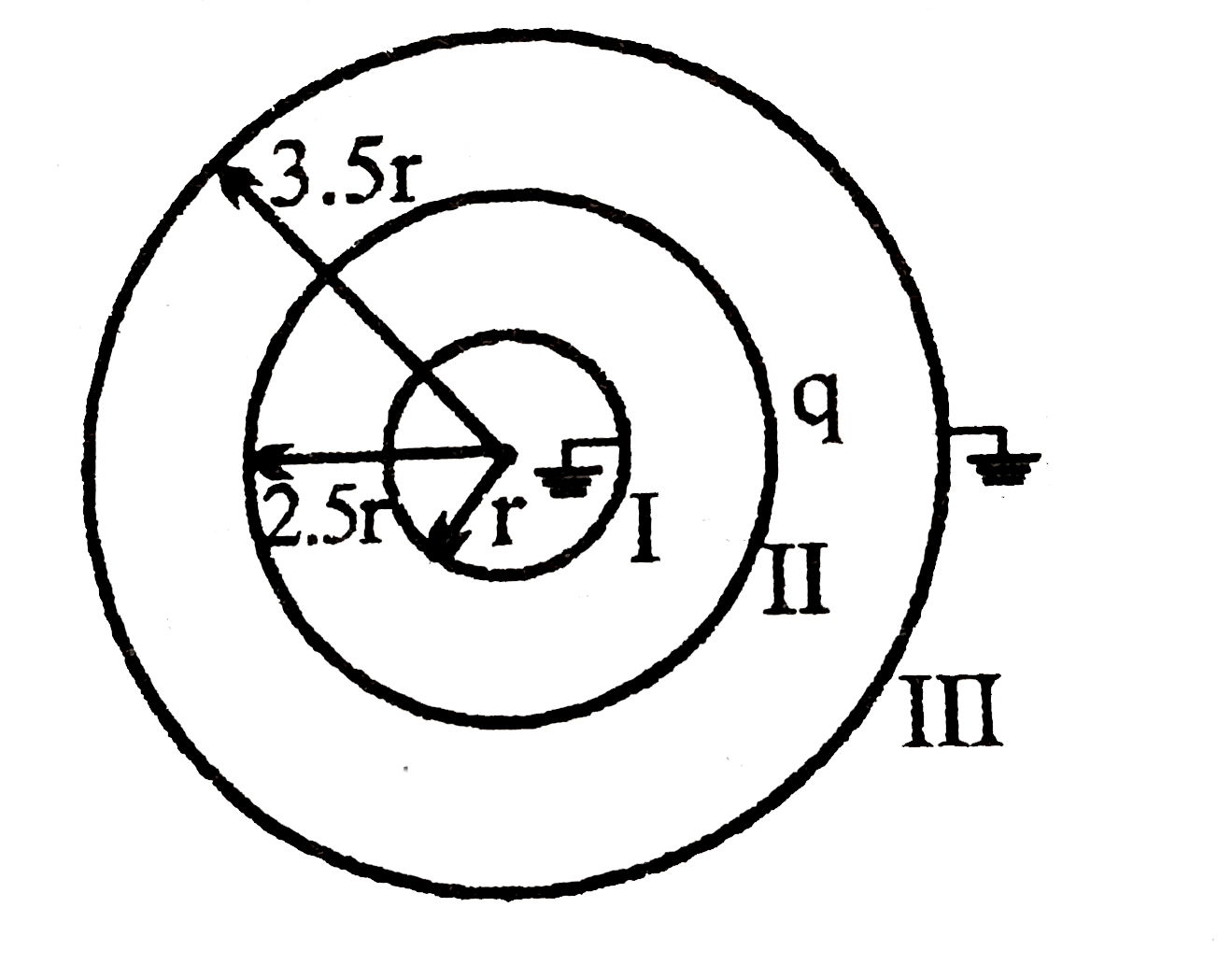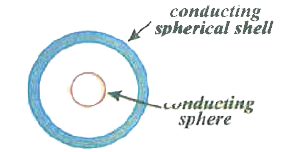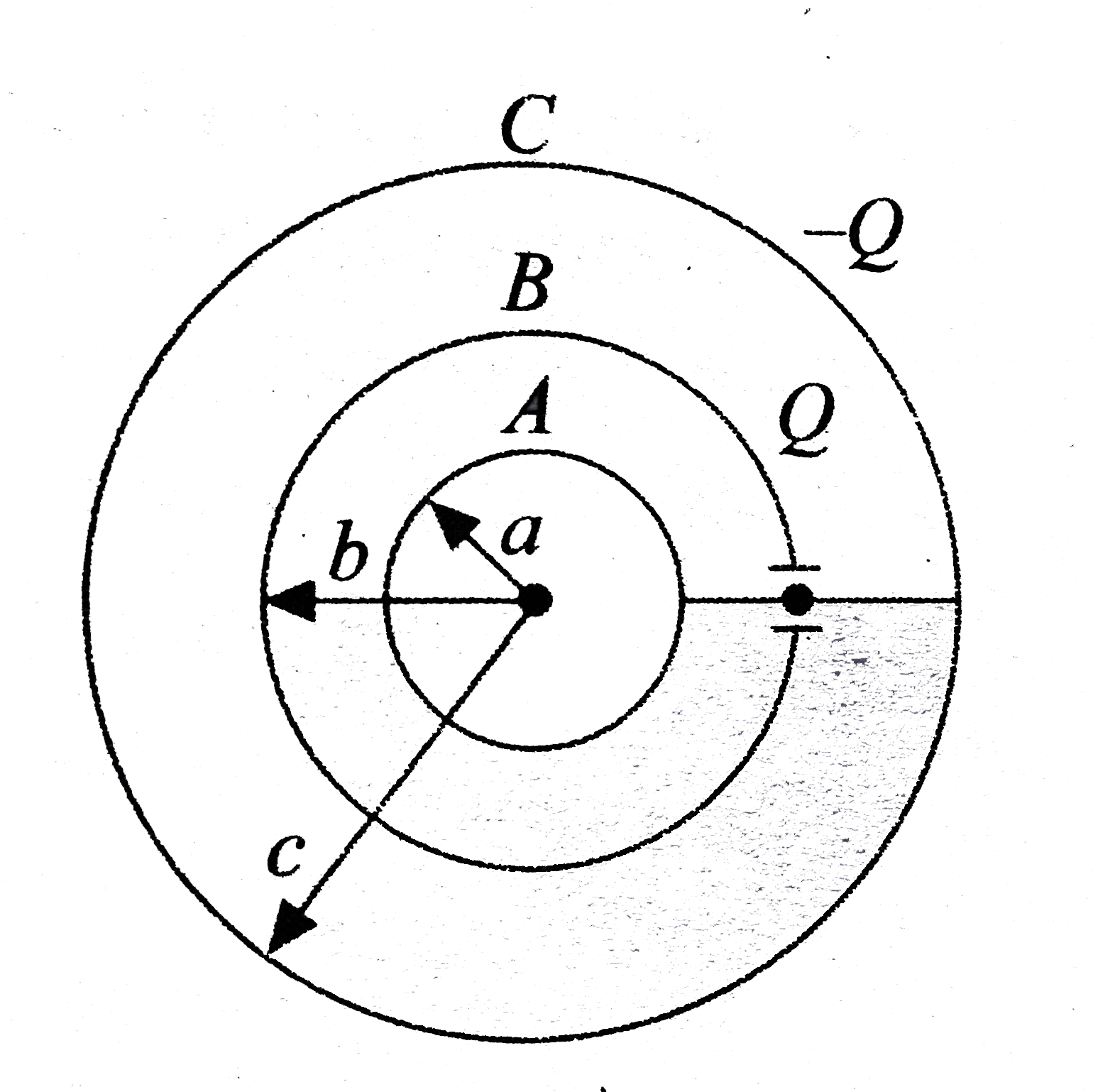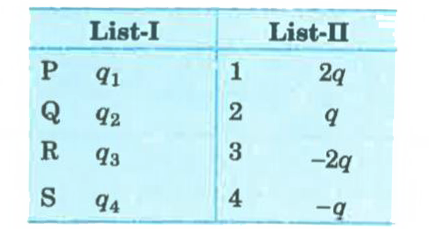Three concentric conducting spherical shells carry charges as : +4Q on the inner shell, −2Q on the middle shell and −5Q on the outer shell. The charge on the inner surface of the outer shell is
0
4Q
−Q
−2Q
The correct Answer is:D
To find the charge on the inner surface of the outer shell, we will analyze the charge distribution on the concentric conducting spherical shells step by step.
1. Identify the Charges on the Shells:
- Inner shell (A) has a charge of +4Q.
- Middle shell (B) has a charge of −2Q.
- Outer shell (C) has a charge of −5Q.
2. Determine Charge Induction on the Inner Surface of the Middle Shell (B):
- The inner shell (A) has a charge of +4Q.
- By electrostatic induction, the inner surface of the middle shell (B) will acquire a charge of −4Q to neutralize the electric field inside the conductor.
3. Determine Charge on the Outer Surface of the Middle Shell (B):
- The total charge on the middle shell (B) is −2Q.
- Since the inner surface has −4Q, the outer surface of the middle shell will have:
Charge on outer surface of B=Total charge of B−Charge on inner surface of B=−2Q−(−4Q)=+2Q
4. Determine Charge Induction on the Inner Surface of the Outer Shell (C):
- The outer surface of the middle shell (B) has a charge of +2Q.
- Therefore, the inner surface of the outer shell (C) will acquire a charge of −2Q to neutralize the electric field due to the +2Q charge on the outer surface of the middle shell.
5. Final Charge on the Inner Surface of the Outer Shell:
- Thus, the charge on the inner surface of the outer shell (C) is −2Q.
Final Answer:
The charge on the inner surface of the outer shell is −2Q.
---
- Inner shell (A) has a charge of +4Q.
- Middle shell (B) has a charge of −2Q.
- Outer shell (C) has a charge of −5Q.
- The inner shell (A) has a charge of +4Q.
- By electrostatic induction, the inner surface of the middle shell (B) will acquire a charge of −4Q to neutralize the electric field inside the conductor.
- The total charge on the middle shell (B) is −2Q.
- Since the inner surface has −4Q, the outer surface of the middle shell will have:
Charge on outer surface of B=Total charge of B−Charge on inner surface of B=−2Q−(−4Q)=+2Q
- The outer surface of the middle shell (B) has a charge of +2Q.
- Therefore, the inner surface of the outer shell (C) will acquire a charge of −2Q to neutralize the electric field due to the +2Q charge on the outer surface of the middle shell.
- Thus, the charge on the inner surface of the outer shell (C) is −2Q.
The charge on the inner surface of the outer shell is −2Q.
Topper's Solved these Questions
- ELECTROSTATICSBOOK - DC PANDEYCHAPTER - ELECTROSTATICSEXERCISE - JEE Advanced
44 Videos
- ELECTROSTATICSBOOK - DC PANDEYCHAPTER - ELECTROSTATICSEXERCISE - Comprehension
36 Videos
- ELASTICITYBOOK - DC PANDEYCHAPTER - ELASTICITYEXERCISE - Medical entrances s gallery
21 Videos
- EXPERIMENTSBOOK - DC PANDEYCHAPTER - EXPERIMENTSEXERCISE - Subjective
15 Videos
Similar Questions
Figure shows three concentric conducting spherical shells with inner and outer shells earthed and the middle shell is given a charge q. Find the charge distribution of sphere

View SolutionFigure shows three concentric conducting spherical shells with inner and outer shells earthed and the middle shell is given a charge q. Find the charge distribution of sphere

View Solution
Knowledge Check
Three concentric conducting spherical shells carry charges +4Q on the inner shell −2Q on the middle shell and +6Q on the outer shell. The charge on the inner surface of the outer shell is
A0B4QC−QD−2QThere are two concentric hollow conducting spherical shells of radii r and R(R>r). The charge on the outer shell is Q. What charge should be given to the inner shell, so that the potential at a point P , at a distance 2R from the common centre is zero ?
A−QrRB−QRrC−2QRrD−Q)A conducting sphere that carries a total charge of -3q is placed at the centre of a conducting spherical shell that carries a total charged of +5q. The conductors are in electrostatic equilibrium. The charges on the inner and outer surfaces of the shell are respectively.
 A+3q,+2qB+q,+qC+2q,+3qD+2q,+7q
A+3q,+2qB+q,+qC+2q,+3qD+2q,+7q
There are two concentric conducting spherical shells of radius rA and rB respectively (rB=2rA). If the inner shell is given a charge Q and outer shell is given a charge 2Q, then the potential difference between the surfaces of the shells will be K=14πε0
View SolutionThree conducting spherical shells have radii (a, b, and c) such that a<b<c (Fig. 3.113). Initially, the inner shell is uncharged, the middle shell has a positive charge Q, and the outer shell has a negative charge −Q.
 .
.
a. Find the electric potential of the three shells.
b. If the inner and outer shells are now connected by a wire that is insulated as it passes through the middle shell, what is the electric potential of each of the three shells ? Also, what is the final charge on each shell ?
View SolutionA conducting sphere carrying charge Q is surrounded by a spherical conducting shell.
a. What is the net charge on the inner surface of the shell?
b. Another charge q is placed outside the shell. Now, what is the net charge on the inner surface of the shell?
c. If q is moved to a position between the shell and the sphere, what is the net charge on the inner surface of the shell?
d. Are your answer valid if the sphere and shell are not concentric?
View SolutionThere are two concentric conducting spherical shells of radii 10 cm and 20 cm. The outer shell is charged to a potential of 50esu while inner shell is earthed. The charge on outer shell is
View SolutionThere are three concentric metallic spherical shells of radii R, 2R and 3q, respectively. The middle spherical shell is connected to earth. Let q1 be the charge appearing on the inner surface of the middle sphere and q2 be the charge on outer surface of the middle sphere. Similarly q3 is the charge appearing on inner surface of outermost sphere and q4 is the charge appearing on outer surface of outermost sphere.

View Solution
